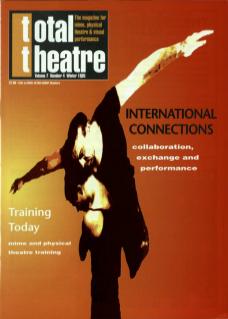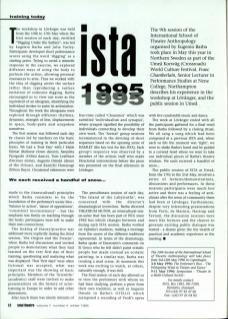The workshop in Lövånger was held from 10-17 May where the first session of each day, entitled ‘Digging Under the Surface’, was led by Eugenio Barba and Julia Varley. Participants developed short performance scores using the word 'digging' as a starting point. Trying to avoid a mimetic response to the exercise, we explored different ways of using the body to perform the action, allowing personal resonances to arise. Thus we worked with the idea of digging under the surface rather than reproducing a surface imitation of someone digging. Barba encouraged us to view our score as the equivalent of an ideogram, identifying the individual strokes to assist its articulation. Throughout the week the ideograms were explored through different rhythms, dynamics, strength of line, displacements in space, body parts and unspoken narratives.
The first session was followed each day by classes led by teachers on the basic principles of training in their particular forms. We had a 'First Day' with I Made Djimat (Balinese clown dancer), Sanjukta Panigrahi (Odissi dance), Tom Leabhart (Decroux mime), Augusto Omulú (dance of the Orixas), and Kanichi Hanayagi (Nihon Buyo). Occasional references were made to the (transcultural) principles which Barba considers to be the foundation of the performer's scenic bios – 'balance in action', 'dance of oppositions', 'consistent inconsistency' – but the emphasis was firmly on teaching through the body; participants were left to make their own connections.
We each received a handful of snow...
The linking of theory/practice was addressed more explicitly during the third session, 'the Origins and the Present’, when Barba led discussions and invited people to demonstrate what they had learned on the very first day of their training, questioning and analysing what was displayed. That 'first days' were often fictional was accepted, what was important was the showing of basic principles. Members of the Scientific (academic) staff were invited to make presentations on the history of actor-training in Europe in order to add other dimensions.
After lunch there was ninety minutes of free-time called 'Chaosmos' which was subtitled 'individualism and synapsis', where synapsis signified the possibility of individuals connecting to develop their own work. The 'formal’ group sessions recommenced in the devising of short sequences based on the opening scene of Hamlet (the key text for this ISTA). Each group's sequence was observed by a member of the artistic staff who made Directorial interventions before the piece was presented on the final afternoon in Lövånger.
The penultimate session of each day, ‘The Island of the Labyrinths’, was concerned with the director's dramaturgical invention. Barba directed Theatrum Mundi, an intercultural mis-en-scene that has been part of ISTA since 1982 but which changes between and during each ISTA session. Barba worked on Ophelia's madness, making a montage from the scores of the different traditions represented. In terms of the dramaturgy, Barba spoke of Eisenstein's comments on El Greco who he felt didn't paint ecstatic people but made instead an ecstatic painting; in a similar way, Barba was creating a mad scene. At moments this work was exciting to watch, at others, naturally enough, it was dull.
The final session of each day allowed us to view the performers with whom we had been studying perform a piece from their own tradition, as well as Augusto Omulú in Barba's Otello which juxtaposed a recording of Verdi's opera with live candomblé music and dance.
The week at Lövånger ended with all the participants gathered for a final word from Barba followed by a closing ritual. We all sang a song which had been composed at a previous ISTA and, when each us felt the moment was 'right', we were to shake Barba's hand and be guided to a covered bowl where we were to take our individual pieces of Barba's theatre wisdom. We each receieved a handful of snow...
The public session of ISTA at Umeå, 17-21 May, involved a series of lectures/demonstrations, discussions and performances. In these sessions participants were much less active and there was a feeling of anticlimax after the sense of community there had been at Lövånger. Furthermore, despite very interesting presentations from Pavis, de Marinis, Hastrup and Taviani, the discussion sessions were more like lectures and the chance to generate exciting public dialogue was wasted – a shame given the wealth of practical and academic experience at the meeting.
The 10th Session of the International School of Theatre Anthropology will take place from 3-12 May 1996 in Copenhagen.

